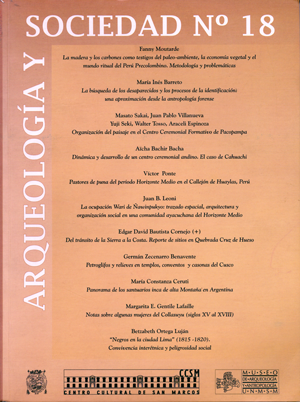Dynamics and development of an Andean ceremonial center. The case of Cahuachi
DOI:
https://doi.org/10.15381/arqueolsoc.2007n18.e13152Keywords:
South Coast, Nasca, Cahuachi, ceremonial center, architecture, habitat, ceramic, offerings.Abstract
On the southern coast of Peru, the famous site of Cahuachi, the greatest establishment of the ancient Nasca, is traditionally interpreted as either hosting an important population or an exclusive ceremonial centre and a pilgrimage destination. Recently, analysis of cultural material reveal the existence of residential sections in the interior of the temples. Archaeological remains, in particular those excavated on periphery of the great monuments show proofs of permanent domestic life. The architectural organization of the ceremonial center tends toward enclosed and isolated spaces, far from the idea of an urban form. These elements pull us to change our mind about the function of this site. n the southern coast of Peru, the famous site of Cahuachi, the greatest establishment of the ancient Nasca, is traditionally interpreted as either hosting an important population or an exclusive ceremonial centre and a pilgrimage destination. Recently, analysis of cultural material reveal the existence of residential sections in the interior of the temples. Archaeological remains, in particular those excavated on periphery of the great monuments show proofs of permanent domestic life. The architectural organization of the ceremonial center tends toward enclosed and isolated spaces, far from the idea of an urban form. These elements pull us to change our mind about the function of this site.Downloads
Published
Issue
Section
License
Copyright (c) 2007 Aïcha Bachir Bacha

This work is licensed under a Creative Commons Attribution-NonCommercial-ShareAlike 4.0 International License.
THE AUTHORS RETAIN THEIR RIGHTS:
a. The authors retain their trademark and patent rights, and also on any process or procedure described in the article.
b. The authors retain the right to share, copy, distribute, perform and publicly communicate the article published in the Arqueología y Sociedad (for example, place it in an institutional repository or publish it in a book), with an acknowledgment of its initial publication in the Arqueología y Sociedad.
c. The authors retain the right to make a subsequent publication of their work, to use the article or any part of it (for example: a compilation of their works, notes for conferences, thesis, or for a book), provided that they indicate the source. of publication (authors of the work, journal, volume, number and date).






